Steinberg UR44 User manual
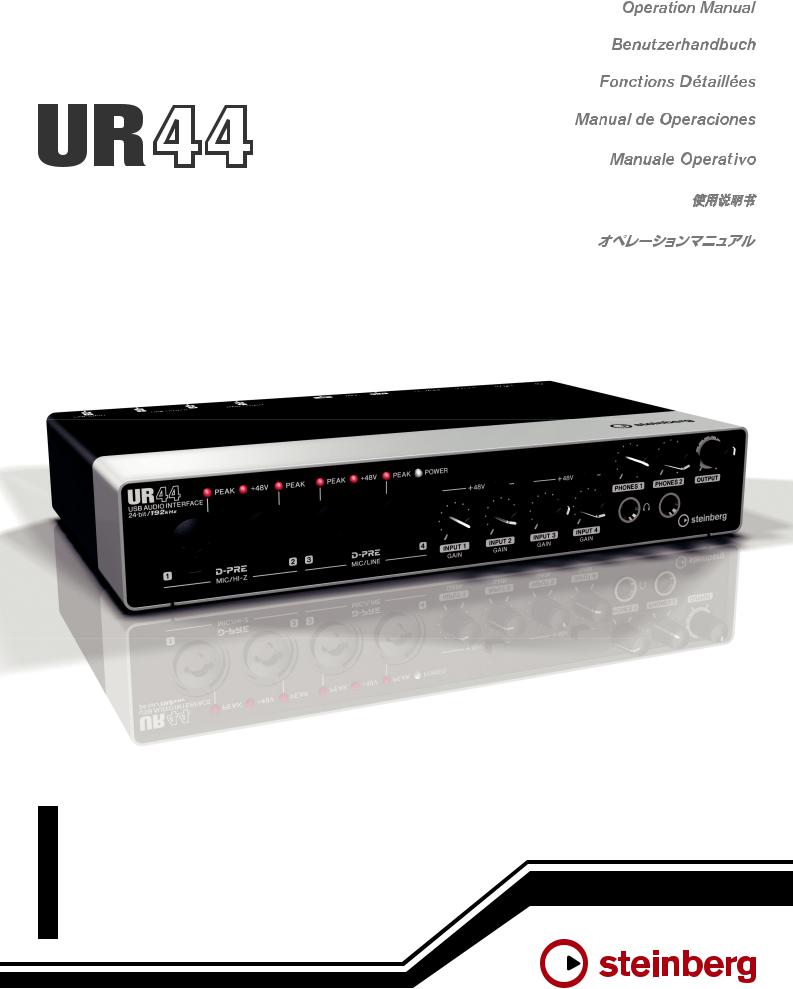
USB AUDIO INTERFACE
EN
DE
FR
ES
I T
ZH
JA

Contents |
|
A Message from the UR44 Development |
|
Team......................................................... |
2 |
Accessory Disk (TOOLS for UR44 CD- |
|
ROM)......................................................... |
3 |
Cubase AI Download .............................. |
3 |
How to Read the Manual......................... |
4 |
Description of the Device ....................... |
5 |
Front Panel...................................................... |
5 |
Rear Panel ...................................................... |
7 |
Software ................................................... |
9 |
Yamaha Steinberg USB Driver (Audio driver) 9 |
|
dspMixFx UR44 (Mixer) ................................ |
10 |
Dedicated Windows for Cubase Series |
|
(Windows for Configuring the Device Settings |
|
from Cubase Series) ..................................... |
15 |
Sweet Spot Morphing Channel Strip |
|
(Compressor and Equalizer)......................... |
18 |
REV-X (Reverb)............................................. |
20 |
Guitar Amp Classics ..................................... |
21 |
Basic Operation..................................... |
24 |
Using the UR44 with a Computer ................. |
24 |
Using the UR44 with an iPad ........................ |
27 |
Troubleshooting.................................... |
30 |
Appendix................................................ |
32 |
Uninstalling TOOLS for UR44 ....................... |
32 |
Signal Flows.................................................. |
33 |
Block Diagrams ............................................ |
35 |
Contents
A Message from the UR44 Development Team
Thank you for choosing the UR44 USB audio interface. The UR44 inherits the design philosophy of the previously released UR22, packing essential music production functions into a compact, durable unit that delivers outstanding sound quality on a par with our high-end models, while adding extra capacity and expandability.
The UR44 includes four D-PRE microphone preamplifiers and allows simultaneous recording of up to six channels. Every aspect of the D-PRE preamplifiers has been painstakingly engineered for optimum sound and overall performance, from parts selection to circuit design. These groundbreaking preamplifiers were first introduced in the Yamaha n12 and n8 digital mixing studios and then implemented in the Steinberg MR816 series and UR28M/UR824 interfaces, where they gained a reputation among discerning musicians and engineers for delivering an exquisite balance of smoothly extended highs, detailed midrange, and fat, punchy lows.
Of course there’s more to music production than just great preamp performance. The same high quality must be maintained throughout the signal path, right up to the outputs that feed the monitor speakers. The UR44 development team has spared no effort in achieving that goal, with emphasis on realizing eminently clear, detailed spatial imaging and dynamic accuracy: left to right, near to far, loud to soft. The same approach was applied in the UR22, but the UR44 benefits from even further refinement overall. The UR44 also includes True Integrated Monitoring for lag-free monitoring while recording, plus top-class REV-X reverb effects, matching our high-end models for recording comfort, efficiency, and effect capability.
The UR44 additionally features Class Compliant mode for iOS support. In Class Compliant mode, the UR44 works with the iPad. It can be used with iOS compatible music production applications such as Steinberg Cubasis for convenient high-quality recording anywhere, at any time. There is also a loopback function that facilitates video delivery and other Internet related activities.
Top-quality recording capability is now available to just about anyone. It is our sincere hope that the UR44 will become a valued creative tool for all artists and engineers who work with sound, from beginners to seasoned professionals.
The Steinberg Hardware Development Team
UR44 Operation Manual 2

Accessory Disk (TOOLS for UR44 CD-ROM)
The TOOLS for UR44 CD-ROM contains the following.
Operation Manual
•UR44 Operation Manual (this document)
•Basic FX Suite Operation Manual
TOOLS for UR44
TOOLS for UR44 is necessary when connecting the device to a computer. Make sure to install it before initially using the device. When you install the TOOLS for UR44, the following three software programs will be installed.
• Yamaha Steinberg USB Driver
This software allows communication between the device and a computer.
• Steinberg UR44 Applications
This software allows setting the parameters of the device from a computer or using the Link function between the device and Cubase series software. The software consists of the following two components.
- dspMixFx UR44
This software lets you set the device when using it with a DAW (Digital Audio Workstation) software other than Cubase series.
- UR44 Extension
This software allows you to link the device with Cubase series (for versions which supports the link function). To use this link function, see the Steinberg web site below.
http://www.steinberg.net/
• Basic FX Suite
Basic FX Suite is software consisting of VST3 Plug-ins of various effects and sound processing developed by Yamaha, some of which fully utilize modeling technology. When you install the Basic FX Suite, the following three software programs will be installed.
- Sweet Spot Morphing Channel Strip
This processing effect is a multi effect that features a compressor and equalizer.
- REV-X
This processing effect is a digital reverb platform developed by Yamaha for professional audio devices.
Accessory Disk (TOOLS for UR44 CD-ROM)
- Guitar Amp Classics
This processing effect features guitar amp simulations developed by Yamaha that fully utilize modeling technology.
NOTE
•TOOLS for UR44 does not support iPad.
•For instructions on using Basic FX Suite, refer to the Basic FX Suite Operation Manual included in the TOOLS for UR44 CD-ROM.
Cubase AI Download
We are offering Cubase AI as a free download via our website, specifically for customers who have purchased the UR44. In order to download the software, you’ll need to first create a MySteinberg account in the Steinberg website. For the latest information, see the Steinberg web site below.
http://www.steinberg.net/getcubaseai/
UR44 Operation Manual 3

How to Read the
Manual
Make sure to read through the following documentation before using the device.
• Read me first (printed)
This is included with the package. Make sure to read through this manual carefully to ensure safe use before initially using the product.
• Getting Started (brochure)
This is included with the package. Read this manual when setting up the device. After finishing the setup as indicated in this manual, read the Operation Manual.
• Operation Manual (PDF)
This is included in the TOOLS for UR44 CD-ROM. Read through this manual to understand how to use the features of the product.
Conventions
Windows or Mac
When the procedures or explanations are specific to only one of the platforms, Windows or Mac, this is properly indicated in the manual. When the platforms do not appear, procedures or explanations are for both Windows and Mac.
Procedures
“” appears on some procedures in the manual. For example, the string “Devices” “Device Setup” “Control Panel” indicates that you should perform the procedures in the following order.
1.Click the “Devices” menu.
2.Select the “Device Setup” option.
3.Click the “Control Panel” button.
How to Read the Manual
Keyboard Shortcuts
[Windows modifier key]/[Mac modifier key] + [key] shows the shortcut keys. For example, [Ctrl]/ [command] + [Z] means “press [Ctrl] under Windows or [command] under Mac, then press [Z].”
Cubase
The phrase “Cubase” in this manual applies to all Cubase programs and versions (except
Cubase LE). If the instructions are only for Cubase, “Cubase only” appears in the manual.
Screens
This manual predominantly uses screenshots of Windows. However, Mac screenshots are used when instructions of the function apply only to the Mac. Also, this manual uses screenshots of Cubase 7. If you are using another version of Cubase, the actual screenshots might not be the same. For details, refer to the Cubase manuals (PDF) opened from the [Help] menu.
Version Information
The letters “x.x.x” and “x.xx” indicate the version number.
UR44 Operation Manual 4
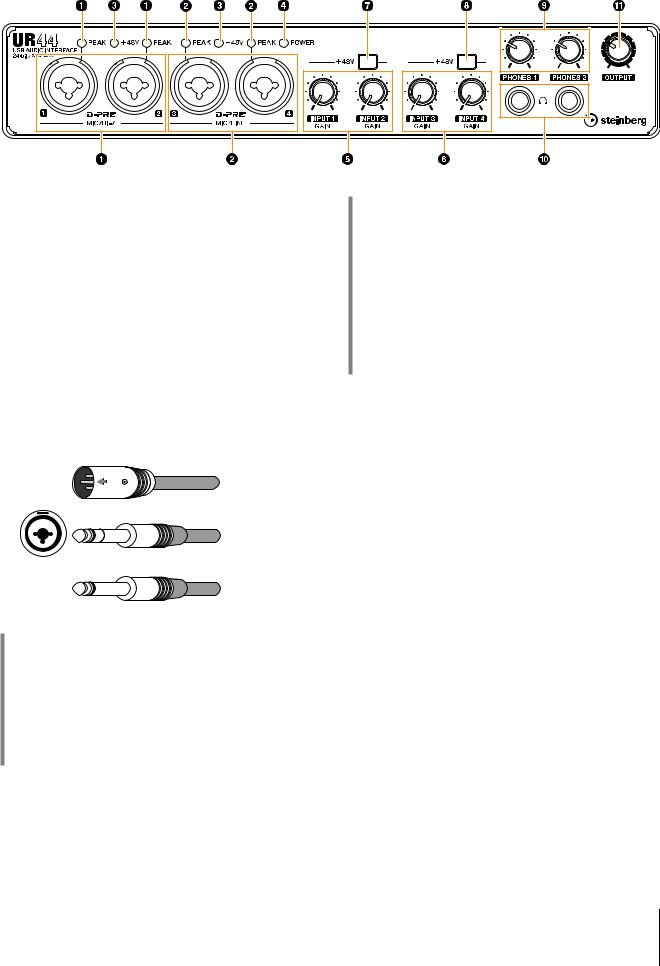
Description of the Device
Description of the Device
Front Panel
1[MIC/HI-Z 1/2] jack/[PEAK] indicator
For connection to a microphone, digital instrument, electric guitar, or electric bass. This jack can be
connected to both XLR-type and phone-type (unbalanced only) plugs*1. The XLR-type is MIC only
and the phone type is HI-Z only. The [PEAK] indicator lights in red when the signal is -3 dB or greater.
2[MIC/LINE 3/4] jack/[PEAK] indicator
For connection to a microphone or digital instrument.
This jack can be connected to both XLR-type and phone-type (balanced/unbalanced) plugs*1. The XLR-
type is MIC only and the phone type is LINE only. The [PEAK] indicator lights in red when the signal is -3 dB or greater.
*1 Plug types
XLR-type (balanced)
Phone-type (balanced)
Phone-type (unbalanced)
HINT
Setting optimum recording levels
The [PEAK] indicator lights in response to the level of input signal. To set optimum recording levels, increase the input level with the [INPUT GAIN] knob until the [PEAK] indicator lights in red, then slowly bring the level down until the indicator lights slightly when the input level is at maximum.
HINT
Proper use of the HI-Z or LINE inputs HI-Z:
•Guitar and bass with passive pickups (batterypowered)
LINE:
•Effect device, preamp, direct box
•Guitar and bass with active pickups (not batterypowered)
•Digital instruments, such as synthesizer
3[+48V] indicator
The indicator lights when the [+48V] switch (phantom power) is turned on.
4[POWER] indicator
The indicator lights when the power is turned on. The indicator flashes continuously when the computer or iPad does not recognize the device.
5[INPUT 1/2 GAIN] knob
Adjusts the input signal level of the [MIC/HI-Z 1/2] jack.
6[INPUT 3/4 GAIN] knob
Adjusts the input signal level of the [MIC/LINE 3/4] jack.
UR44 Operation Manual 5
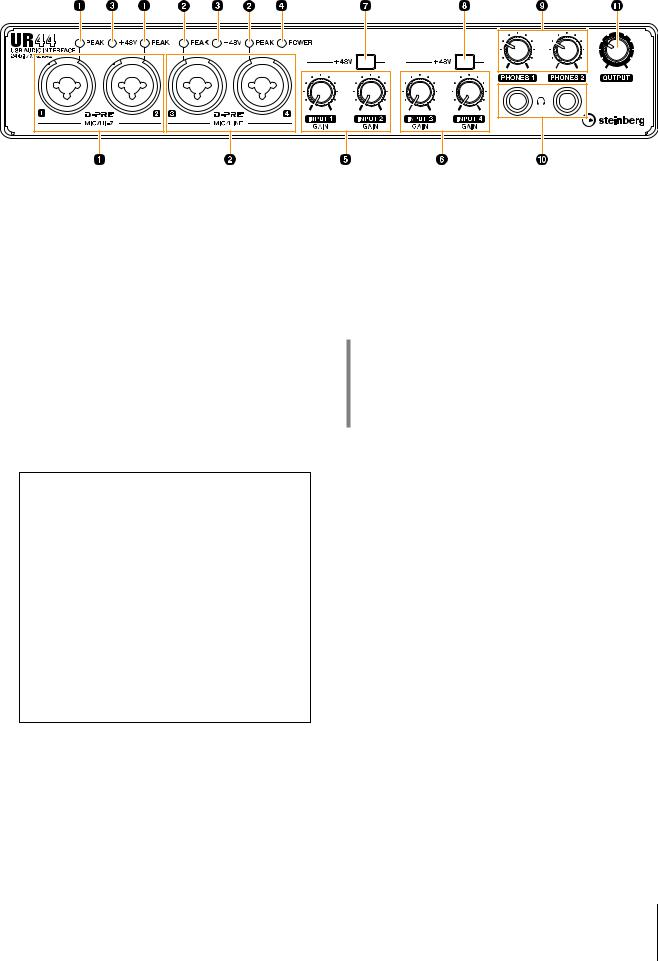
7[+48V] switch
Turns the phantom power on (O) and off (N). When you turn this switch on, phantom power will be supplied to the [MIC/HI-Z 1/2] jack. The [+48V] indicator lights when the switch is turned on. Turn this switch on when using a phantom powered condenser microphone.
8[+48V] switch
Turns the phantom power on (O) and off (N). When you turn this switch on, phantom power will be supplied to the [MIC/LINE 3/4] jack. The [+48V] indicator lights when the switch is turned on. Turn this switch on when using a phantom powered condenser microphone.
Phantom Power Precautions
 CAUTION
CAUTION
Always turn phantom power OFF when it is not required.
When using phantom power, observe the following to prevent noise and possible damage to UR44 or connected equipment.
•When connecting devices not requiring phantom power to the [MIC/HI-Z 1/2] [MIC/LINE 3/4] jacks, make sure to turn phantom power OFF.
•Do not connect or disconnect any devices while phantom power is turned ON.
•Set all output level controls to minimum when turning phantom power ON or OFF.
9[PHONES 1/2] knobs
For adjusting the output signal level of the [PHONES] jack. The [PHONES 1] knob adjusts the output of the corresponding [PHONES 1] jack below it, while the [PHONES 2] knob adjusts the output of the corresponding [PHONES 2] jack. This output signal level is not affected by the [OUTPUT] knob.
Description of the Device
)[PHONES 1/2  ] jack
] jack
For connection to a set of headphones. [PHONES 1] outputs the MIX 1 signals. [PHONE 2] outputs the MIX 1 or MIX 2 signals. To select the output signal of the [PHONES 2], refer to “Headphone Area” (page 17) in the section “dspMixFx UR44” or the “Headphones Window” (page 13) in the section “Dedicated Windows for Cubase Series.”
HINT
What is MIX?
MIX refers to the stereo output signals which flow in the device. The input signals to the device flow to each MIX. Refer to the section “Signal Flow” (page 33).
![OUTPUT] knob
Adjusts the output signal level of the [MAIN OUTPUT] jacks. This output signal level is not affected by the [PHONES] knob.
UR44 Operation Manual 6

Rear Panel
1[P] (Standby/On) switch
Sets the power of the device to On (O) or Standby (N).
 CAUTION
CAUTION
Even when the [P] switch is in the standby position, electricity is still flowing to the unit. If you do not plan to use the unit for a while, be sure to unplug the AC power adaptor from the outlet.
NOTICE
•Setting the [P] switch to on and standby in rapid succession can cause it to malfunction.
•After setting the [P] switch to standby, wait for about six seconds before setting it to on again.
NOTE
When setting the [P] switch to standby, the settings on the Scene (page 11) and [PHONES 2] output signal are saved to the device settings. Please note that the settings are not saved if you turn the power off by disconnecting the power cable when the [P] switch is on.
2DC IN [12V]
For connection to the AC power adaptor.
Description of the Device
3[USB 2.0] port
For connection to a computer or iPad. Apple iPad Camera Connection Kit or Lightning to USB Camera Adapter are required when connecting the UR44 with an iPad.
USB Port Precautions
NOTICE
Be sure to observe the following points when connecting to the computer’s USB interface. Failing to do so may result in the computer freezing or shutting down, as well as corruption or even loss of data. If the device or computer does freeze, restart the application or computer.
•Be sure to wake the computer from sleep/suspended/stand by mode before making a connection to the computer’s USB port.
•Before turning on the power to the device, connect the computer to the USB port.
•Before turning on/off the device or plugging/unplugging the USB cable, quit any open application software on the computer.
•When connecting or disconnecting the USB cable, be sure to set all output level controls to the minimum.
•Wait at least six seconds between connecting or disconnecting the USB cable.
4[CC MODE] switch
Turns the Class Compliant mode on and off. Make sure to turn the [CC MODE] switch on when connecting the device to an iPad. Also, make sure to turn the
[CC MODE] switch on before turning on the
[P] switch. The Class Compliant mode will not change if the [CC MODE] switch is turned on after the
[P] switch has been turned on.
UR44 Operation Manual 7
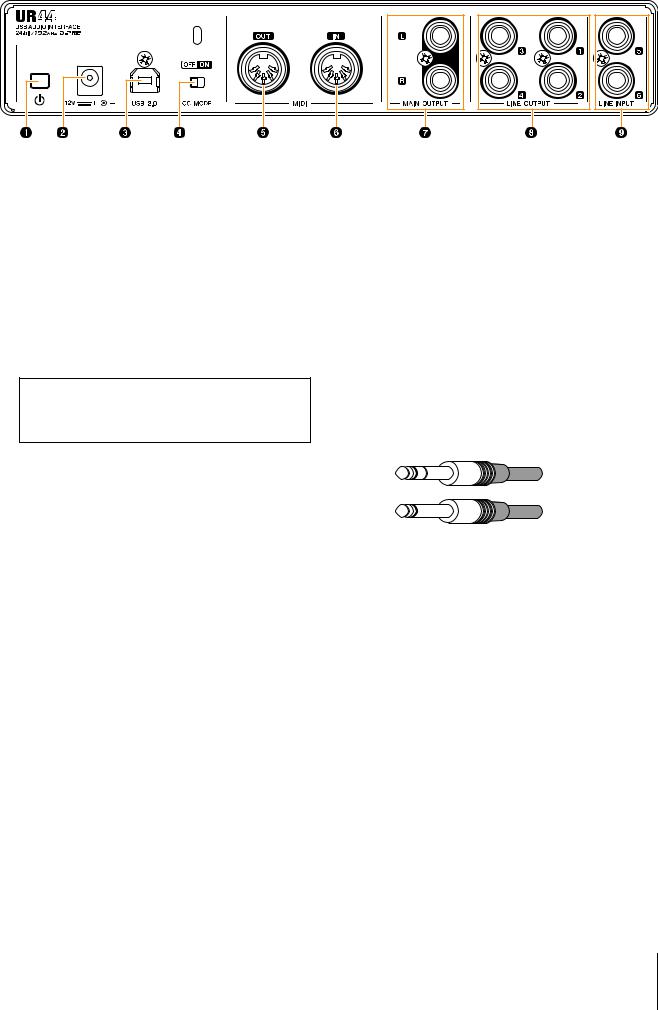
5[MIDI OUT] jack
For connection to the MIDI IN jack of a MIDI device. This transmits MIDI signals from the computer.
6[MIDI IN] jack
For connection to the MIDI OUT jack of the MIDI device. This receives and inputs MIDI signals to the computer.
Select [Steinberg UR44-1] for the MIDI port when using a MIDI jack with an iPad application. Please note that [Steinberg UR44-2] is not available.
7[MAIN OUTPUT] jacks
For connection to monitor speakers. These jacks can
be connected to phone-type (balanced/unbalanced) plugs*2. This outputs the MIX 1 signals. To adjust the
output signal level, use the [OUTPUT] knob on the front panel.
8[LINE OUTPUT 1 to 4] jacks
For connection to external devices with line level
signals. These jacks can be connected to phone-type (balanced/unbalanced) plugs*2. The [LINE OUTPUT
1/2] jack outputs the MIX 1 signal and the [LINE OUTPUT 3/4] jack outputs the MIX 2 signal.
Description of the Device
9[LINE INPUT 5/6] jacks
For connection to digital instrument. These jacks can
be connected to phone-type (balanced/unbalanced) plugs*2. You can select the input signal level of the
[LINE INPUT 5/6] jacks between “+4 dBu” and “-10 dBV.” Select “+4 dBu” when connecting a
professional audio device, and select “-10 dBV” when connecting a consumer device. The default initial setting is “-10 dBu.” To select the input signal level, use the “Setup Window” (page 14) in the section “dspMixFx UR44” or the “Settings Window” (page 17) in the “Dedicated Windows for Cubase Series.”
*2 Plug types
Phone-type (balanced)
Phone-type (unbalanced)
UR44 Operation Manual 8
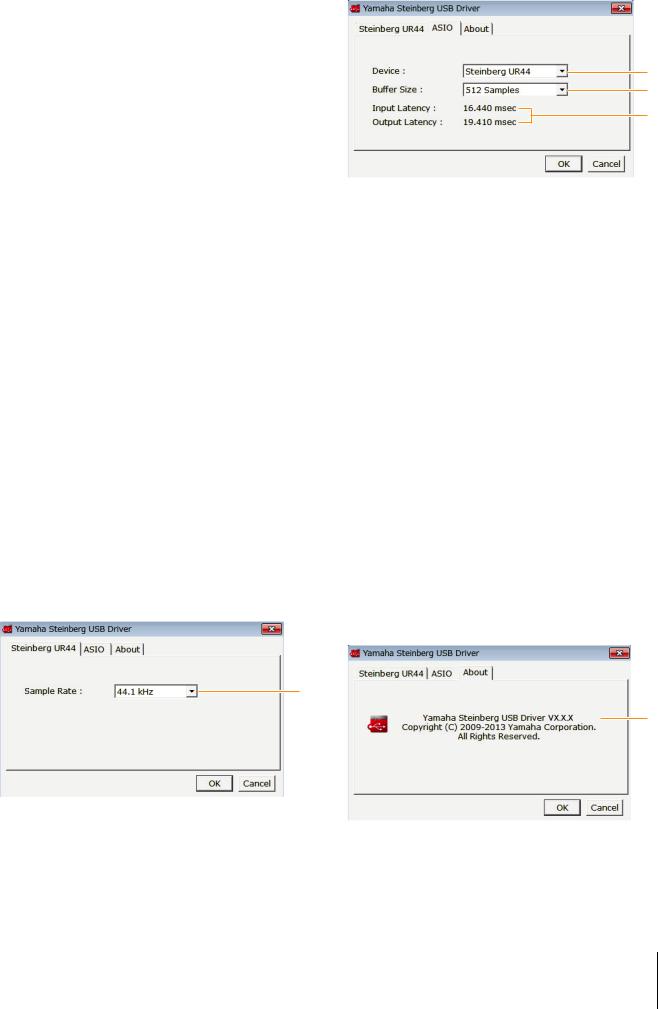
Software
Introduction
This section explains software operations for using the UR44 with a computer.
NOTE
The software programs below do not apply to iPad.
Yamaha Steinberg USB Driver (Audio driver)
Overview
Yamaha Steinberg USB Driver is a software program which allows communication between the UR44 and a computer. Yamaha Steinberg USB Driver has a control panel from which you can select the general settings of the audio driver for Windows and view the information for Mac.
Windows
How to Open the Window
•[Control Panel] [Hardware and Sound] or [Sounds, Speech, and Audio Devices] [Yamaha Steinberg USB Driver]
•From the Cubase series menu, [Devices] [Device Setup…] [Yamaha Steinberg USB ASIO] [Control Panel]
How to Switch the Window
Click the upper tabs to select the desired window.
Steinberg UR44 window
This window is for selecting the sample rate of the device.
1
1 Sample Rate
Selects the sample rate of the device.
Options: 44.1 kHz, 48 kHz, 88.2 kHz, 96 kHz, 176.4 kHz, 192 kHz
NOTE
For Mac, select the sample rate of the device via the Audio MIDI Setup.
Software
ASIO window
This window is for selecting the ASIO driver settings.
1
2
3
1 Device
Selects the device that will be using the ASIO driver. This function is available when connecting to the computer two or more devices to the computer that are compatible with the Yamaha Steinberg USB Driver.
2 Buffer Size
Selects the buffer size for the ASIO driver. The range varies depending on the specified sample rate.
Sample Rate |
Range |
|
|
44.1 kHz/48 kHz |
64 Samples – 2048 Samples |
|
|
88.2 kHz/96 kHz |
128 Samples – 4096 Samples |
|
|
176.4 kHz/192 kHz |
256 Samples – 8192 Samples |
|
|
3 Input Latency/Output Latency
Indicates the delay time for the audio input and output in millisecond units.
Audio latency varies depending on the value of the ASIO buffer size. The lower the value of the ASIO buffer size, the lower the value of audio latency.
About window
This window indicates information about the audio driver.
1
1 About
Indicates the version and copyright of the audio driver.
UR44 Operation Manual 9
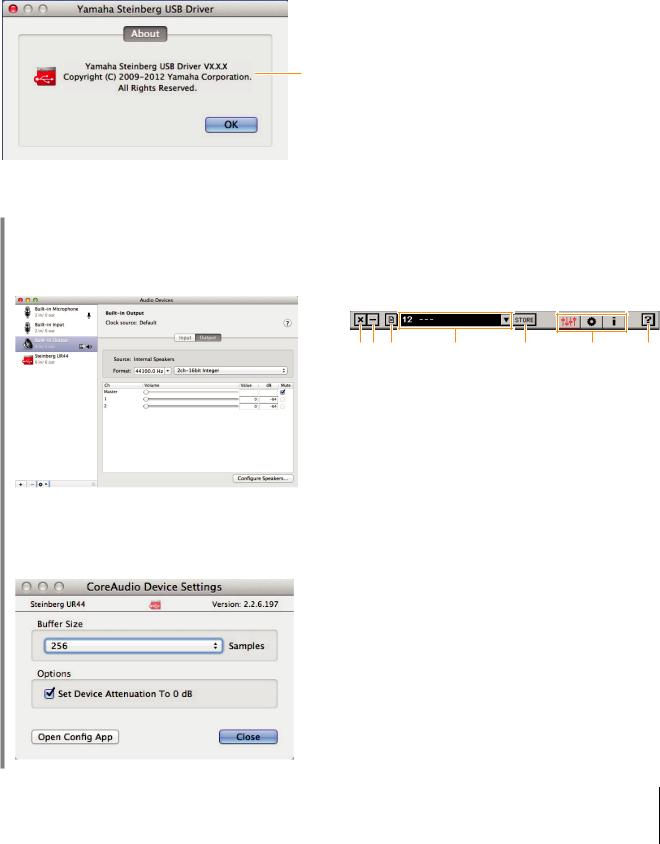
Mac
How to Open the Window
•[System Preferences] [Yamaha Steinberg USB]
•From the Cubase series menu, [Devices] [Device Setup…] [Steinberg UR44] [Control Panel] [Open Config App]
About window
This window indicates information about the audio driver.
1
1 About
Indicates the version and copyright of the audio driver.
HINT
How to select the sample rate
Select the sample rate of the device from [Audio MIDI Setup].
How to select the buffer size
Select the buffer size in the window for selecting buffer size, which can be opened from an application, such as DAW software.
Software
dspMixFx UR44 (Mixer)
Overview
This software is for operating the convenient built-in DSP mixer and DSP effects. The DSP mixer allows you to mix up to six input channels down to two stereo outputs. A number of DSP effects for processing the input signals are also provided, and since the processing/mixing is hardware-based, there is no monitoring latency.
NOTE
You cannot operate dspMixFx UR44 while a Cubase series DAW is running. When Cubase is running, configure the DSP mixer and DSP effect from “Dedicated Windows for Cubase Series”
(page 15).
How to Open the Window
Windows
[All Programs] or [All apps] [Steinberg UR44] [dspMixFx UR44]
Mac
[Applications] [dspMixFx UR44]
Controls and Functions
Tool Area
This is the area for configuring the overall common settings of dspMixFx UR44.
12 3 |
4 |
5 |
6 |
7 |
1 Quit
Quits dspMixFx UR44.
2 Minimize
Minimizes the dspMixFx UR44 window.
3 Menu
Provides four different menus for various settings.
Menu |
Description |
|
|
Open |
Opens the settings file of dspMixFx |
|
UR44. |
|
|
Save |
Saves the settings file of dspMixFx |
|
UR44 to a computer. |
|
|
Import Scene |
Imports a scene from the settings file of |
|
dspMixFx UR44. Select the desired |
|
settings file of dspMixFx UR44 and |
|
import the desired scene on the left |
|
side of the [IMPORT SCENE] window. |
|
The window appears after the file is |
|
selected in the file selection dialog. |
|
Select the destination for importing on |
|
the right side of the window. Click [OK] |
|
to import it. |
|
|
UR44 Operation Manual 10
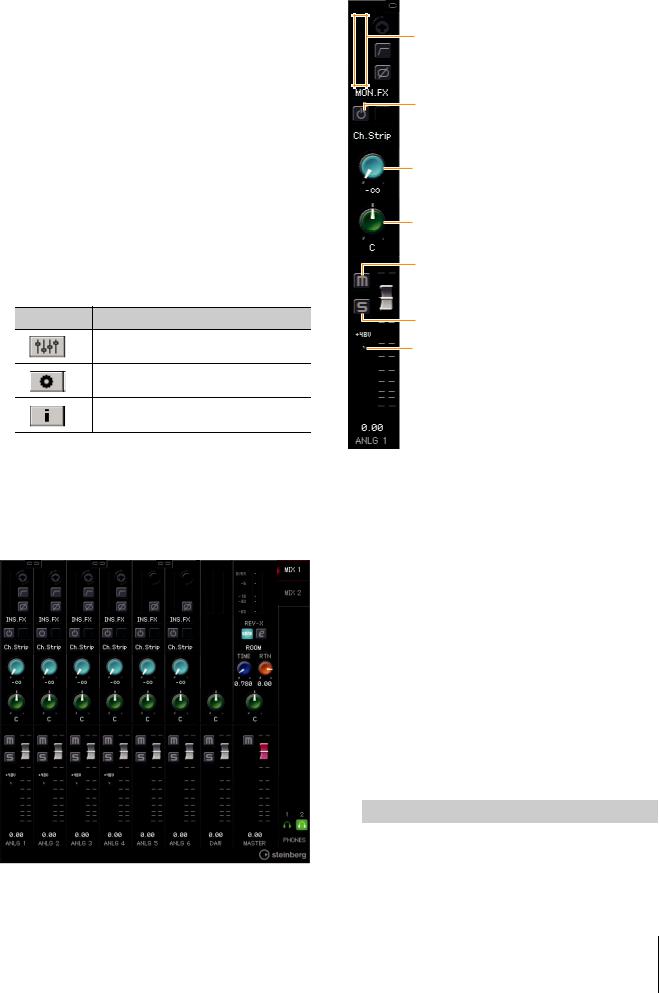
Menu |
Description |
|
|
Initialize All |
Deletes all the saved scenes. |
Scenes |
|
|
|
4 Scene
Indicates the scene name. You can change the scene name by clicking on it.
Clicking the button on the right opens the window for calling up other scenes. Call up the desired scene by clicking it. To cancel calling up the scene, click outside of the window.
5 STORE
Opens the scene store window. Enter the desired scene name into the STORE NAME field. Select the destination for storing the scene in the No. NAME field. Click [OK] to store the scene.
6 Selecting windows
Selects the desired dspMixFx UR44 window. The selected window icon will light in red.
Menu Description
Main window (page 11)
Setup window (page 14)
Information window (page 14)
7 Help
Opens the Operation Manual (this manual).
Main Window
This window is for configuring the entire signal flow.
Software
Channel Area
This is the area for configuring the input channel settings.
 1
1
2
 3
3
 4
4
 5 6
5 6  7
7
 8
8
9
)
!
 $
$
@
#
1 Channel Link
Turns on (lit) and off (dark) the channel link of two adjacent channels. When you turn this on, two mono channels will become one stereo channel.
2 Level Meter
Indicates the signal level.
3 High Pass Filter
Turns on (lit) and off (dark) the high pass filter (not available on [LINE INPUT 5/6] ). To select the cutoff frequency of the high pass filter, use the “Setup Window” (page 14) in the section “dspMixFx UR44.”
4 Phase
Turns on (lit) and off (dark) the phase inversion of the signal.
5 Effect Insertion location
Selects the insertion location of an effect.
Options |
Description |
|
|
MON.FX |
Applies an effect to only the monitor signal |
|
(sent to the device). |
|
|
INS.FX |
Applies an effect to both the monitor signal |
|
(sent to the device) and the recording signal |
|
(sent to a DAW software). |
|
|
UR44 Operation Manual 11

6 Effect On/Off
Turns the Effect on (lit) and off (dark).
7 Effect Edit
Opens (lit) and closes (dark) the selected effect setup window.
8 Effect Type
Indicates the effect type.
The maximum number of Channel Strip and Guitar Amp Classics iterations which can be used simultaneously has restrictions. Refer to the “Limitations on the use of effects” (page 34).
9 REV-X Send
Adjusts the signal level which is sent to REV-X.
Range: -∞ dB – +6.00 dB
) Pan
Adjusts the pan.
Range: L16 – C – R16
! Mute
Turns the mute on (lit) and off (dark).
@ Solo
Turns the solo on (lit) and off (dark).
# +48V
Indicates the on/off status of the phantom power function of the device.
$ Fader
Adjusts the signal level.
Range: -∞ dB – +6.00 dB
Software
DAW Area
This is the area for configuring the DAW channel settings.
 1
1
2
3
 5 4
5 4
1 Level Meter
Indicates the signal level.
2 Pan
Adjusts the pan.
Range: L16 – C – R16
3 Mute
Turns the mute on (lit) and off (dark).
4 Solo
Turns the solo on (lit) and off (dark).
5 Fader
Adjusts the signal level.
Range: -∞ dB – +6.00 dB
UR44 Operation Manual 12
